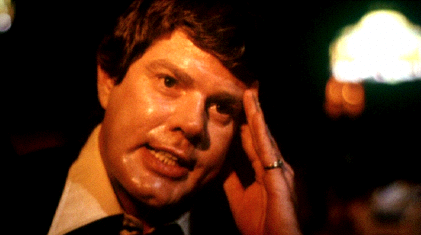Director: Albert Ray
Writers: Kurt Kempler, Frances Hyland
Producer: M.H. Hoffman
Cast: Ginger Rogers, Lyle Talbot, Purnell Pratt, Harvey Clark, Lillian Harmer, Arthur Hoyt, Louise Beavers (as Louise Beaver), Clarence Wilson, (and uncredited cast members) Maurice Black, Jim Farley, Cyril Ring, Tiny Sandford, Philip Sleeman, Dick Rush
In the middle of the night at the towering Harker Apartments Building in New York City, the millionaire owner Adam Harker falls screaming from his penthouse to his death. Newspaper reporter Pat Morgan (Ginger Rogers) has been posing as Harker’s live-in secretary to investigate his rumored ties to organized crime. Ted Rand (Lyle Talbot) is another reporter from a rival newspaper also trying to get a scoop on this case as he tries to woo Pat. Despite their competition, Pat and Ted cooperate trying to find the reason for Harker’s death as more bodies turn up in the Harker Apartments.
The Flashback Fanatic movie review
A Shriek in the Night is another of those little B-film thrillers from the 1930s that has plenty of humor, a tricky murder gimmick, and fine performances from the main players. It also has an atypical approach to its characters. The lead protagonists that are the most appealing and who get the most screen time are not as instrumental in solving the mystery as other seemingly minor characters. These developments are more of a surprise than the reveal of the villain.
This film certainly begins with a bang, or actually with a shriek and a thud to be more precise. The brief opening credits have barely had time to finish before the first death via high dive off of the Harker Apartments Building occurs. This grim event is immediately dealt a bit of irreverence as one happily boozed-up bystander assumes that the fresh corpse of Harker is drunk. This is just the first hint of how this film will confound a lot of our expectations about crime thriller conventions.
A tipsy crime scene gawker is only the first of many indications that the prohibition era was running out of steam. Booze was on the brain of a restless public anticipating the legalization of intoxicants. This is another early ’30s film in synch with that sentiment. Characters frequently indulge in drink and reference going to speakeasies. One shady character’s last name is Martini (Maurice Black). Even Police Inspector Russell (Purnell Pratt) savors the scent from a bottle of booze at a crime scene. This irreverence for the legal restrictions about alcohol seems to carry over into the narrative’s disregard for genre expectations and creates an overall sense of mischief. This flick even gives us more than one way for characters to get “gassed.”
Ginger Rogers had already starred just the previous year in another Albert Ray-directed mystery thriller, The Thirteenth Guest (1932). Being just on the verge of superstardom in 1933, Rogers stars here as newspaper reporter Pat Morgan. All it takes is her beauty and relaxed charm to make us pay attention to her simple character in this odd, little yarn. Later that year, Rogers’ movie immortality really took off by appearing for the first time with Fred Astaire in Flying Down to Rio (1933).
Lyle Talbot had also co-starred with Ginger Rogers in that earlier Albert Ray film. At this time Talbot was in the midst of his six-year Warner Brothers contract and probably at the height of his fame. He was often cast in villain roles and, as Talbot wished to play good guys, he must have relished the opportunities getting loaned out to appear as the heroic lead in a couple of Albert Ray’s B-flicks. In later years he would have a long career as a character actor on film and television. Superhero fans know him best for being the first film actor to play Commissioner Gordon in the serial Batman and Robin (1949) and Superman’s archenemy Luthor in the serial Atom Man vs. Superman (1950). Cult film fans will remember Talbot’s appearances in three of famed bad movie director Ed Wood’s films: Glen or Glenda (1953), Jail Bait (1954), and Plan 9 from Outer Space (1957).
In A Shriek in the Night, Rogers and Talbot as our leads are the attractive couple we think are going to hook up, despite their playful antagonism. Since they are both newspaper reporters, we also expect them to solve the mystery. This film devotes plenty of attention to them, but there are other characters that actually prove to be just as instrumental in getting to the solution of this case. It can even be argued that the Rogers and Talbot characters of Pat Morgan and Ted Rand are not really solving the mystery but just spicing up the plot with some humor and romance.
Another character that is a change of pace is Police Inspector Russell. Unlike many other such figures in crime thrillers featuring amateur sleuths, this official representative of law enforcement seems quite capable and likable. Russell doesn’t want reporters interfering with his investigation, but he is quite civil and intelligent. He even seems to take a genuine liking to Ginger Rogers’ Pat Morgan; the guy has great taste. Yet in spite of the respect this character is portrayed with, he is not picking up all of the crime-solving slack left by our romantic leads.
Many horror and mystery films of this era had comic relief characters. There are several here, as well, such as the panicky maid Augusta (Lillian Harmer) and Inspector Russell's meek secretary Wilfred (Arthur Hoyt). However, some of them are absolutely vital in dealing with this film’s mystery and menace. That is another quirk in this offbeat, little thriller that does not always meet expectations. It seems to suit the sense of mischief running throughout the story.
Despite all of this disregard for typical genre character responsibilities, there are a few macabre touches that help to maintain the intrigue. Exactly how the victims are being killed is as puzzling as the killer’s identity. The murderer also indulges in a bit of mental sadism by sending a peculiar warning card to the intended victims.
Director Albert Ray does not get too fanciful in his direction. He does not need to do much in a film with a short running time and the humor of the Rogers and Talbot performances to keep things moving. Ray does use the interesting trick a few times of having scenes become very dark as we lose sight of characters to keep us disoriented and in suspense. This has a nice payoff as A Shriek in the Night reaches its climax in the film’s most irreverent touch.


















































